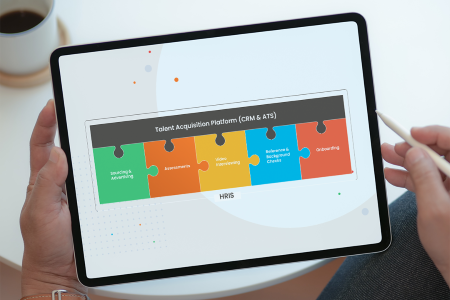
Seismic shifts in technology and society have made people everywhere savvy, digital consumers. Everyone (employees, candidates and HR practitioners) have expectations that technology should deliver high quality processes in an intuitive, fast, ‘don’t make me think’ way. And because we have this experience as consumers, we expect this in every area of our lives, both at work and at home. As a result, we’re seeing a key trend of modern HR leaders’ remit to buy, integrate and implement HR technologies that deliver experiences, not just processes. Given the thousands of HR technology products available in the market, sifting through them can be overwhelming. Great leaders know it’s important to manage complexity and uncover challenging questions before making an investment decision; and the first question faced by HR leaders when buying HR tech is: do I buy best-of-breed or all-in-one?
Best-of-Breed or All-in-One HR Technology?
For HR Directors – it’s already hectic being in human resources. You deliver multiple large-scale processes, such as performance appraisals and salary reviews, future-proof your workforce’s capabilities (you’re probably implementing a new competency matrix as you read this) and managers demand vacancies be filled immediately, despite how busy your recruitment team is with a backlog of vacant roles. You know that in order to deliver on ‘experience’, you need new technology. So you check out some fancy best-of-breed HR technologies, but being a novice at technology integrations, it’s fairly daunting. So you buy an all-in-one Human Capital Management platform which promises to deliver on all the HR functions you need, except that it doesn’t, and you wonder where did it all go so wrong?
Despite past experience or concerns, new technologies are now easier than ever to integrate and deliver the outstanding outcomes you need. Josh Bersin’s HR tech report says savvy Human Resources leaders now focus on having a larger number of the right Human Resources systems, and build quality integrations in order to create exceptional user experiences. In order to do this, Bersin says HR leaders should focus on best-of-breed to deliver such experiences. Ultimately, he recommends that HR leaders should create a tech stack with one stable core HR platform to warehouse all your employee data and additional technology products (from innovative vendors) to solve each unique HR or business problem.
To make it simple, we’ve broken down how savvy HR Directors design, integrate and implement the right HR technology stack in order to achieve their goals. With 6 simple steps, you can explore HR platforms and realise the right tech you need to deliver your companies’ outcomes, whether they are employee engagement, talent acquisition or employment management needs.
Six steps to uncover the right HR tech for your organisation:
- Explore the argument between best-of-breed vs all-in-one
- Learn about the “system of record” vs the “system of engagement”
- Explore the business problems first and find the technology second
- Learn the basics of integrations
- Make a decision on best-of-breed vs all-in-one
- Design your ideal tech stack
1. Best-of-Breed versus All-in-One
Firstly, let’s discuss best-of-breed versus all-in-one HR technology solutions because all HR technology decisions come down to this.
What is a best-of-breed technology?
A best-of-breed technology refers to a product that is the best of its type and has been developed to solve a particular problem, or address a specific niche or functional area (e.g. video interviewing or talent management solutions).
What are the typical benefits of best-of-breed?
- Software-as-a-service (SaaS) technology that is designed to target specific or unique problems;
- Features a modern look and feel, plus an intuitive user experience;
- Laser focused on product development and improvement, meaning vendors invest in updates and pivot with market needs; and
- Being small and nimble, vendors are excited to work with clients to co-create system improvements and can often shape the future of the technology to suit your needs.
Some examples of best-of-breed tech?
LiveHire is an example of a best-of-breed recruitment and talent mobility software. Further examples in the recruitment space would be Enboarder for Onboarding, CVCheck or Xref for background/reference checking, FlareHR for benefits and compliance, and MyInterview for video interviewing.
Client Story: Learn how Alfred Health uses the seamless SuccessFactors and LiveHire integration
What is an all-in-one technology?
An all-in-one technology refers to an all-encompassing suite-based system, with only one major vendor provider. Many all-in-one technologies start as market leaders and then buy other technologies to fill product tech gaps in their software.
What are the benefits of all-in-one tech?
- The platform has a standard suite of modules which may cater to all of your functional areas.
- All-in-one may be appealing from a contracting perspective, since it’s typically just one technology vendor and an implementation partner.
- It should offer a unified user interface across all the different modules.
What about the drawbacks?
There is no denying that working with a single vendor has advantages. However, working with a single vendor also has its downsides. You may have heard the phrase, ‘jack of all trades, master of none’. An all-in-one solution can feel like a Swiss Army knife, with tools for every job, but none of them is actually fit for purpose.
When software companies grow by acquiring other products they can bolt on as modules, there’s a risk that the ‘all-in-one’ solution won’t actually feel seamless because the modules weren’t originally designed to work together. They have to work much harder to ensure their code is communicating between systems and often the capital needed to obtain perfect synchronicity is not worth the investment for the organisation.
Beyond creating a clunky, unpleasant user experience, pursuing an all-in-one strategy can lead to a wide range of unexpected costs.
- More staff needed – Some organisations have expanded the size of their Talent Acquisition teams by 20-30% after implementing an all-in-one solution. Despite including an applicant tracking system, the solution required significantly more clicks and offered less communication tools, causing huge inefficiencies for recruiters, hiring managers, and candidates.
- More money spent on job ads – If you’re relying on a clunky, outdated applicant tracking system as part of your all-in-one solution, it’s unlikely you’ll be able to proactively create talent pools and develop a pipeline of candidates before a hiring need arises. Instead, you’ll be left with a reactive option – to post job ads and pray for the right candidate to find you. This approach is less effective and takes 2-3 times longer.
- More money spent on recruitment agencies – Less proactive recruitment also means you’ll be more reliant on recruitment agencies, which often charge 15-20% per placement.
So, while pursuing an all-in-one strategy may seem like a financially responsible approach at the outset, it is far more expensive in the long run.
2. System-of-record vs System-of-engagement?
In recruitment, there is no question that modern hiring software is needed to win the competitive game of securing the best talent. It is well established that best practice hiring technologies use a system-of-engagement software rather than system-of-record. ‘Systems of Record’ are the Enterprise Resource Planning (ERP) systems which organisations use to run their business (financials, manufacturing, Sales CRM, HR). They are built for process compliance, not human engagement. Josh Bersin notes they were “traditionally designed for people who have no choice but to use them.” Conversely, ‘Systems of Engagement’ are technologies that are used directly by employees, as Bersin says, for socially “sticky uses” in order to get work done – for example email, collaboration, new social networking, hiring and learning systems.
System-of-record hiring software is a standard product for most all-in-one HR platforms. This means organisations are unable to access system-of-engagement technologies using solely an all-in-one HR technology. Many of our clients use LiveHire as their recruitment platform despite having an option to use the ‘out-of-the box’ recruitment module in their Human Capital Management (HCM) system. While these clients have the option to use their HCM’s recruitment module as an all-in-one solution, they prefer to use LiveHire for recruitment due to the easy ability to engage with and delight their candidates and new hires and continue to use their HCM for all other HR processes. By integrating LiveHire as their best-of-breed solution into their all-in-one HCM, they ensure they get the best of both worlds – a seamless hiring experience plus smooth management of staff across the employee lifecycle.
3. Business problems first, HR tech second
Deciding on which best-of-breed technology can be time consuming. To reduce this burden, Josh Bersin says “When it comes to making decisions about HR technology, a lot of us do it backward. We start with the technology and try to fit it to our problems, rather than the other way around…Rule of thumb: business problem first, HR technology second.” Therefore you need to spend time being your own management consultant: talk to leaders, gather data, diagnose issues, analyse to confirm diagnosis, and synthesise information to create a complete picture of business problems. Then correlate these to the talent issues and clearly articulate as your HR goals.
Lastly, structure this into a coherent narrative for an executive audience. Follow McKinsey’s Pyramid Principle to ensure you give your executive team a defined problem and answer first, written in clear and concrete form. And then provide supporting reasons, insights and data. In business we often apply the reverse approach by starting with reasons and data, but it is more powerful for executives if delivered in the reverse. This is because executives think in a top down way and you will have the most impact and persuasion communicating the same way.
Once you have a clear picture and buy-in for business issues and HR goals, you have a more refined lens with which to examine the HR tech marketplace. This helps cut through the noise of 1,400+ HR tech vendors and enables the delivery of both HR and business goals. For detailed information on how to create your internal technology business case, download our technology Business Case Playbook.
4. Integrations don’t need to be scary!
The concept of integrating technologies can feel intimidating and fraught with risk, but it can be relatively straightforward as long as you ask the right questions.
- Firstly, is the technology you’re buying really ‘all-in-one’?
- On the surface it appears logical that an all-in-one technology should work seamlessly, but this is not always the case. It’s a little known fact that most all-in-one technologies are made up of one core technology platform, plus a number of bolt-on technology products purchased by the vendor at a later date. The resulting ‘Franken-tech’ product can feel clunky and lead to bugs and UX challenges. Furthermore these sub-products do not get the investment dollars allocated to do improvements and upgrades, as they are superseded by the core product. As a result, each sub-product does not talk to each other and the main platform, in the seamless way imagined, and HR is sold a vision that never materialises.
- What options do you have to integrate best-of-breed technologies?
- Vendors will often claim that their technology is integrated with a large number of tech providers, but what does that really mean? There are a variety of ways to pass information between systems, as noted below.
We recommend consulting with your technology provider to outline what you’re trying to achieve through the integration and determine which method makes the most sense. While it seems counterintuitive at first, best-of-breed technologies can be less work for your team to integrate. The reasons for this are twofold: (1) best-of-breed products are designed to integrate and (2) they typically have outstanding implementation and organisational support models. Most best-of-breed technologies have specifically designed their platforms to be friendly to other technologies (watch this LiveHire webinar for more information) as it’s in their best interest to integrate with as many platforms as possible. Additionally they have dedicated technical experts, in your local timezone, whose sole job is helping you implement and integrate successfully.
5. End the debate: best-of-breed wins
Today’s companies’ challenges are more complex, more unstructured and unlike anything we have seen before (Josh Bersin Academy bersinacademy.com). This is distinct from the past when problems were challenging but usually well understood and framed by a stable business environment. It’s our opinion at LiveHire, that these unstructured problems, inherent with complexities and instabilities, mean HR Directors must demand best-of-breed technology as a matter of survival. It should be well designed, integrate easily and able to quickly deliver on current complex issues and pivot with changing business needs.
Looking further afield at other business functions, Marketing as an example, has been on a technology journey similar to the one HR is embarking on now. Interestingly, Gartner research shows Marketing teams have evolved from preferring all-in-one technologies towards best-of-breed. Gartner reports only 29% of marketers choose all-in-one solutions, contrasting with 57% who choose best-of-breed. The reasons marketers give for this is that “many users find that the “Marketing Cloud” [ie all-in-one software] they purchased still contains substantial gaps, whether a lack of interoperable applications or data models, inconsistent user experiences, feature gaps or incomprehensible solution pricing”. Sound familiar? It’s easy to swap “Marketing Cloud” with “Human Capital Management technology (HCM)” and the concept resonates with current HR experience and thinking.
6. Design your HR tech stack
So, having decided to leverage best-of-breed, what next? Design your HR tech stack, keeping in mind these tips from a Marketing tech stack playbook, which have been adapted for HR:
- Construct a HR tech stack visualisation that establishes a single source of truth for employee data at the center, and shows where each “connecting” technology solution will fit within your overarching HR tech structure;
- Review your business objectives, does your current HR tech stack deliver on these? What is missing? Where are you doubling up? What could be retired or changed?
- Conduct a cost-benefit analysis for all tools to rein in sizable expenses and get more value from new and existing HR tools (contact each account manager and book in a meeting before the product renewal date – make sure you are getting value from the technology and if not, ask how they can help you);
- Assess your team’s technology proficiency (and train your existing staff or hire some tech savvy HR people) to ensure you have the skills needed to fully utilise the products you plan to purchase;
- Review all processes to ensure that stakeholders and responsibilities are well defined and communicated; and
- Audit your HR tech stack regularly to make sure each stakeholder is extracting the desired return on investment from individual tools and the stack as a whole.
How HR Leaders should proceed
The debate between best-of-breed versus all-in-one is not an either/or question. The true answer (as in most of life) is that ‘it depends’. It depends on your business context and challenges. It depends on your HR goals. Are you looking for a ground-breaking talent management system with advanced analytics? A futuristic employee experience? Or a digital tool that will allow your workforce to work in a remote setting? Whatever you’re looking for, the ultimate answer may be that both solutions could work for your organisation.
From a recruitment lens, the best HR Directors leverage best-of-breed technologies to source, engage and manage prospective employees. A best practice recruitment technology stack includes: a core recruitment platform like LiveHire, plus additional bespoke products suited to each unique business need, for example video-interviewing, assessments, background checks, and onboarding. These technologies may then integrate data into a HCM platform, which in turn stores and manages each worker after they are hired.
This model delivers real business outcomes such as: reducing spend on job boards and recruitment agencies; and finding, wooing and hiring potential employees at speed. The best HR leaders know this and leverage best-of-breed technologies suited to their needs, sometimes coupled with a HCM platform to deliver outstanding business results.
Want to learn more about how LiveHire can help you with your best-of-breed technology needs? Book in a demo with us today or visit our integration marketplace to learn more about the seamless integrations built into LiveHire.
Interested in learning more about integrations? Check out our webinar Bringing your Tech Stack to Life with Integrations.



